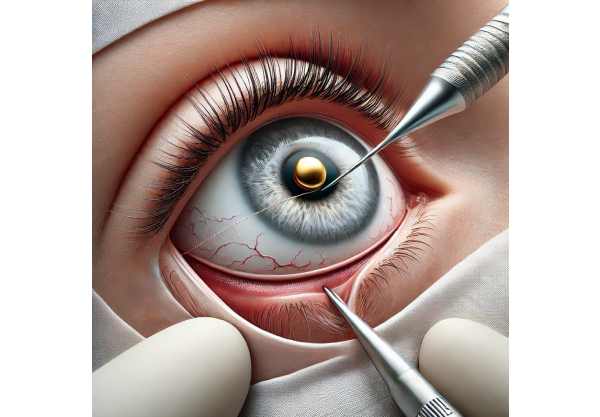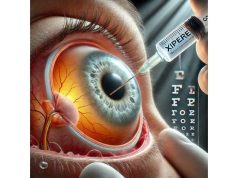Lagophthalmos Overview
Lagophthalmos is an ocular condition defined by the inability to fully close the eyelids, resulting in incomplete or partial eye closure. This condition can progress to exposure keratopathy, in which the cornea becomes dry, irritated, and vulnerable to damage as a result of prolonged exposure to the environment. Facial nerve paralysis (such as Bell’s palsy), trauma, scarring from previous surgeries, congenital anomalies, and certain neurological disorders are all potential causes of lagophthalmos. Symptoms of lagophthalmos include dry eyes, irritation, redness, foreign body sensation, and, in severe cases, vision impairment due to corneal ulcers or infections.
A thorough clinical examination, including slit-lamp biomicroscopy to assess the ocular surface and corneal health, is required to diagnose lagophthalmos. Additional diagnostic tests, such as fluorescein staining and Schirmer’s test, may be used to assess tear production and detect corneal damage. Understanding the underlying cause of lagophthalmos is critical to developing an effective treatment plan. This article delves into traditional approaches to managing lagophthalmos and discusses the most recent innovations that have significantly improved patient outcomes.
Traditional Methods of Lagophthalmos Treatment
Historically, the treatment of lagophthalmos has centered on symptom relief and protecting the ocular surface from further damage. Traditional treatment methods have included a mix of conservative measures, medical interventions, and surgical procedures, depending on the severity of the condition and its underlying cause.
Conservative Measures
For mild cases of lagophthalmos, conservative measures are frequently sufficient to manage symptoms and prevent complications. These measures include the following:
- Artificial Tears and Lubricating Ointments: Using artificial tears during the day and lubricating ointments at night helps keep the ocular surface moist and reduces dryness and irritation.
- Eyelid Taping: Taping the eyelids shut during sleep can provide temporary relief while also protecting the cornea from exposure. This method is frequently used in combination with lubricating ointments.
- Moisture Goggles: Wearing moisture goggles or eye patches can create a humid environment around the eyes, which reduces evaporation and keeps the ocular surface hydrated.
Medical Interventions
If conservative measures fail to alleviate lagophthalmos symptoms, medical intervention may be required. The interventions include:
- Botulinum Toxin Injections: Botulinum toxin (Botox) injections can temporarily paralyze the upper eyelid’s levator muscle, allowing the eyelid to close more completely. This treatment is especially beneficial for patients who have mild to moderate lagophthalmos due to facial nerve palsy.
- Tarsorrhaphy is a surgical procedure that involves partially sewing the eyelids together to narrow the palpebral fissure and reduce corneal exposure. This procedure may be temporary or permanent, depending on the patient’s condition and the severity of the lagophthalmos.
Surgical Procedures
In more severe cases of lagophthalmos, or when other treatments have failed, surgical procedures may be required to restore eyelid function and protect the ocular surface. Traditional surgery options include:
- Eyelid Gold or Platinum Weight Implants: Inserting small gold or platinum weights into the upper eyelid can aid in gravity-assisted closure. These weights are usually sutured into place in an upper eyelid pocket. The choice between gold and platinum is based on the patient’s specific requirements and potential allergic reactions.
- Canthoplasty and Lid Shortening: Canthoplasty entails tightening and repositioning the lateral canthal tendon to narrow the palpebral fissure and improve lid closure. Lid shortening procedures are also available to correct eyelid malpositions and improve lid function.
- Facial Nerve Grafting or Muscle Transposition: In cases of facial nerve paralysis, nerve grafting or muscle transposition procedures may be considered to restore eyelid function. These complex surgeries entail transferring nerves or muscles from other parts of the body to reactivate the paralyzed eyelid.
Traditional approaches to managing lagophthalmos have been effective, but they have limitations. Surgical procedures, in particular, can pose risks such as infection, scarring, and the need for subsequent surgeries. Furthermore, some treatments may only provide temporary relief, necessitating ongoing monitoring and intervention.
Breakthrough Innovations in Lagophthalmos Treatment
Advances in medical technology and surgical techniques have resulted in the development of novel treatments for lagophthalmos, significantly improving patient outcomes and overall quality of life. These cutting-edge innovations aim to provide more effective, less invasive, and safer treatments for this difficult condition.
Minimal Invasive Surgical Techniques
Minimally invasive surgical techniques have transformed the treatment of lagophthalmos by lowering the risks and recovery times associated with traditional procedures. These approaches include the following:
- Endoscopic Procedures: Endoscopic techniques use small incisions and specialized instruments to perform precise surgical interventions that cause minimal disruption to surrounding tissues. Endoscopic brow lift and midface lift procedures can treat lagophthalmos caused by facial nerve paralysis, restoring eyelid function and facial symmetry.
- Laser-Assisted Surgeries: Laser technology has improved the accuracy and safety of eyelid surgery. Laser-assisted tarsorrhaphy, for example, allows for more controlled tissue ablation and less scarring, which leads to better cosmetic results and faster recovery.
Advanced Biomaterials and Implants
The development of advanced biomaterials and customizable implants has transformed the surgical treatment of lagophthalmos. These innovations include:
- Bioengineered Eyelid Weights: Bioengineered eyelid weights made from biocompatible materials like titanium or bioabsorbable polymers are more safe and effective than traditional gold or platinum weights. These weights can be precisely tailored to the patient’s anatomical and functional requirements, thereby improving the outcomes of eyelid weight implantation procedures.
- Customizable Implants: 3D printing technology has enabled the development of patient-specific implants such as eyelid weights and orbital prostheses. These custom implants offer a precise fit and optimal functionality, lowering the risk of complications and improving surgical outcomes.
Regenerative Medicine and Tissue Engineering
Regenerative medicine and tissue engineering have expanded the treatment options for lagophthalmos by encouraging tissue repair and regeneration. These approaches include the following:
- Stem Cell Therapy: Stem cell therapy uses autologous or allogeneic stem cells to regenerate damaged tissues and restore eyelid function. Mesenchymal stem cells (MSCs) and adipose-derived stem cells (ADSCs) have demonstrated promise in preclinical studies due to their ability to differentiate into various cell types and promote tissue healing.
- Growth Factor Therapy: Growth factors like platelet-rich plasma (PRP) and fibroblast growth factor (FGF) can aid in tissue regeneration and repair. PRP injections, for example, have been used to promote healing in patients suffering from lagophthalmos caused by scarring or trauma.
Neurostimulation and Neuromodulation
Neurostimulation and neuromodulation techniques have emerged as promising treatments for lagophthalmos, particularly in cases resulting from facial nerve paralysis. These approaches include the following:
- Electrical Stimulation: Electrical stimulation devices can activate facial muscles and encourage eyelid closure in patients with facial nerve palsy. TENS and FES have been used to improve eyelid function and relieve lagophthalmos symptoms.
- Magnetic Stimulation: Transcranial magnetic stimulation (TMS) is a non-invasive technique for stimulating neural activity. TMS has the potential to reactivate facial nerves and improve muscle function in patients with facial paralysis.
Genetic Therapy
Gene therapy is a cutting-edge approach to treating lagophthalmos that targets the genetic causes of facial nerve paralysis. This novel treatment involves delivering therapeutic genes to affected cells to restore normal function. Although still in the experimental stage, preliminary studies in animal models have yielded promising results, paving the way for future clinical applications.
Artificial intelligence and robotics
The combination of artificial intelligence (AI) and robotics has transformed ophthalmic surgery, particularly the treatment of lagophthalmos. AI algorithms and robotic systems improve surgical precision, accuracy, and efficiency, leading to better patient outcomes and a lower risk of complications.
- AI-Powered Diagnostics: AI-powered diagnostic tools can analyze large datasets of imaging and clinical data, resulting in accurate and timely assessments of lagophthalmos. These tools can detect subtle anatomical changes and predict the likelihood of successful surgical intervention, thereby assisting clinicians in treatment planning and decision making.
- Robotic-Assisted Surgery: Robotic-assisted surgery, which employs robotic arms and advanced imaging systems, provides unparalleled precision and dexterity in delicate eyelid procedures. Surgeons can precisely control the robotic instruments, performing complex maneuvers and suturing techniques that would be difficult with traditional methods. The integration of AI algorithms improves the capabilities of robotic systems by allowing for real-time adjustments and optimizing surgical outcomes.











